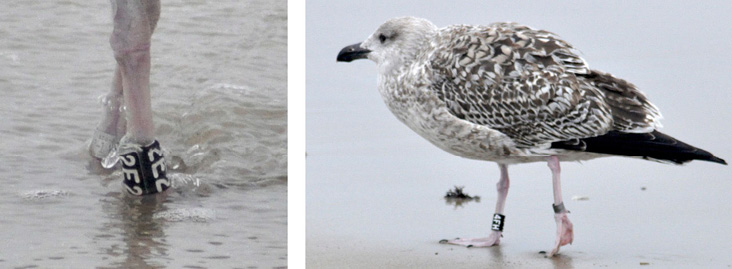Jeffrey Boone Miller

Two banded Great Black-backed Gulls. Left: 2E2. Right: 4FH. Photographs by the author.
At about 11:00 am on October 23, 2017, I came upon two banded Great Black-backed Gulls (Larus marinus) on the beach near the southern boundary of the Parker River National Wildlife Refuge on Plum Island, Massachusetts. Had more shorebirds or waterfowl been around, I might have overlooked these gulls, but, once I noticed their bands, I stopped to spend a few minutes observing them. One of the gulls was a hatch year bird that carried a black band on its right leg with the code 4FH in white lettering. The second gull was an adult with a similar band on its left leg labeled 2E2. Both gulls also had metal bands on their opposite legs, but these were not readable in the field. The accompanying photographs show a close up of 2E2's bands and a portrait of 4FH. As it turned out, these gulls had a story.
After a short Internet search, I found that these bands were of the type used by researchers on Appledore Island, Maine, who have been banding Herring and Great Blacked-backed gulls since 2004. Appledore Island is near the maritime border between Maine and New Hampshire about seven miles offshore, and it's about a 20-mile direct flight from Appledore Island to the where I saw the birds. I reported my sightings as requested on the project's website: <https://gullsofappledore.wordpress.com>.
Not long after my submission, I received an email from Bill Clark, a volunteer with the Appledore project who coordinates correspondence about band sightings. He confirmed that 2E2 and 4FH had been banded on Appledore, and he sent me details of their life histories and previous sightings.
These records showed that the mature gull, 2E2, was at least 15 years old when I saw it. When 2E2 was banded on May 26, 2006, it was already in adult plumage and thus must have been at least four years old. For comparison, the oldest reported Great Black-backed Gulls in Europe and North America have been at least 32 and 26 years old, respectively (Fransson et al. 2017, Lutmerding et al. 2017).
Furthermore, the hatch year bird, 4FH, was an offspring of 2E2, so it was a parent-chick pair that I observed. 4FH was banded July 11, 2017, so it was four and half months old when I saw it. It was the second chick to hatch in the nest of 2E2 and its mate 9ET, a bird I did not see. During the few minutes that I observed 2E2 and 4FH, the two birds remained calmly within a few meters of each other at the water line, sometimes slowly walking a short distance one way or another. Neither was foraging and there were no physical interactions between the two—they just seemed to be companionably in each other's company. My photography did not seem to disturb them.
For at least five years, 2E2 has been raising chicks and interacting with the fledglings. In addition to my sighting in 2017, reports from each of the years from 2013–2016 had also found 2E2 in the company of a banded juvenile. In some reports, observers noted that 2E2 shared food with the accompanying youngster. Observers also noted that 2E2 is an opportunistic feeder, having been seen eating skates, scavenging a seal carcass, and pilfering popcorn and crackers from beachgoers.
The list of sightings also showed that 2E2 has not traveled far. As noted on the project website, Great Black-backed Gulls banded on Appledore have been seen as far west as Indiana and as far south as Texas and Florida. In contrast, every one of the more than 125 reported sightings of 2E2 has been from either Appledore Island, especially in May during the breeding season, or Plum Island in most months, though most often in fall and winter. 2E2 prefers the southern end of Plum Island, as almost all sightings have been from near the southern boundary of the Parker River NWR—where I also saw it—or from the adjacent Sandy Point State Reservation which occupies the southernmost tip of the island.
Every bird we see has a history, but that history is usually unknowable. In the case of 2E2 and 4FH, however, the records from Bill Clark and the staff at the Appledore gull banding project gave me insight and appreciation for the lives these birds are leading. I am grateful that the Appledore team shared their records with me. In particular, I am captivated by 2E2. Though a homebody, 2E2 has reached a respectable age, is an eclectic forager, and is an attentive parent—my definition of a successful gull. For more information about banded gulls and an earlier sighting of 2E2, see Dave Adrien's "A Close Look at Banded Gulls" in Bird Observer 44(5): 316-323. It is available online at <https://www.birdobserver.org/Issues/2016/October-2016/ArticleId/193/a-close-look-at-banded-gulls>.
References